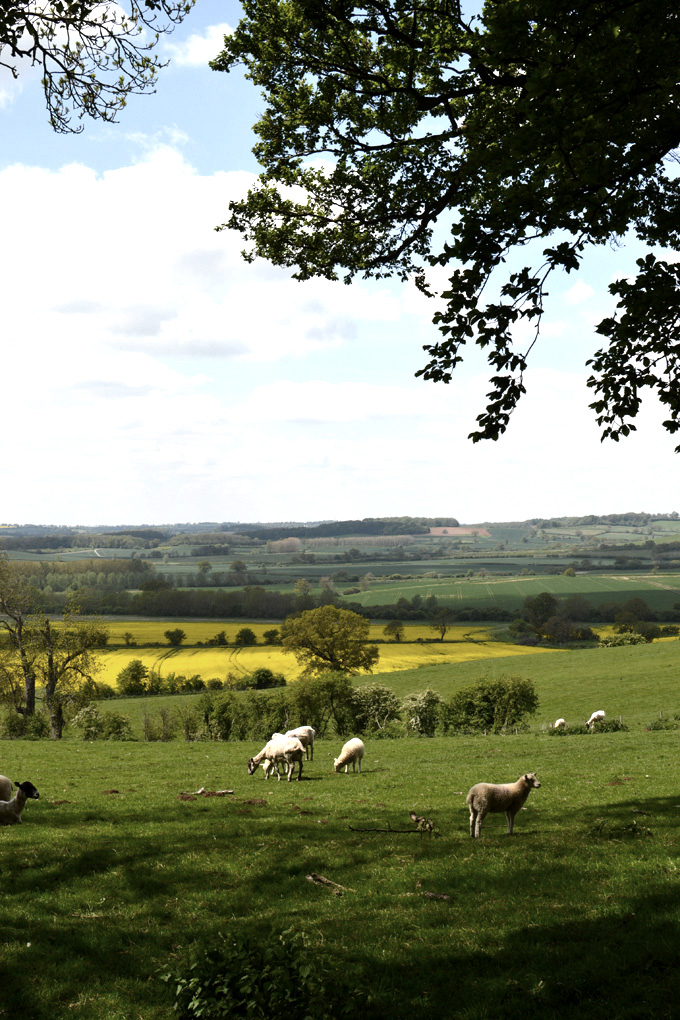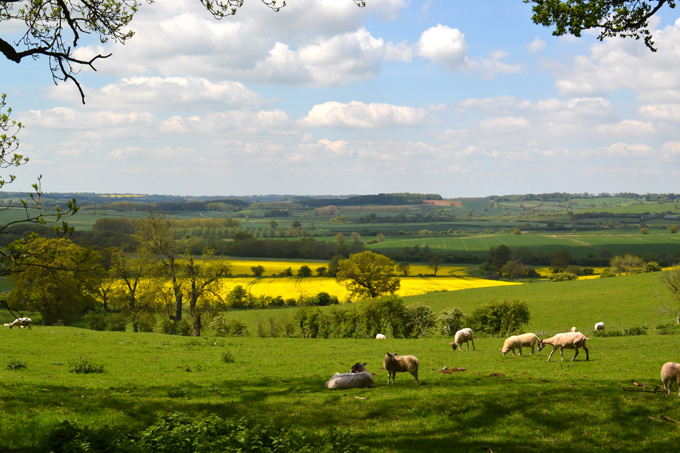
I’ve been using Rapeseed oil in my sourdough courses. I use it to oil my hands when I am handling and shaping my sourdough and in recipes such as muffins and beetroot cake. It’s wonderful to bake with. As the UK’s answer to olive oil, it is in many way’s it’s healthier and certainly it is easier to bake with then olive oil. At this time of year you can’t miss the expanding sea of yellow oil seed rape fields as you drive through much of the countryside surrounded by arable farmland. Yet this is a recent phenomenon and I wondered just how ethical or sustainable rape seed oil actually is?
In John Kirkland The Modern Baker Confectioner and Caterer, volume 2, published in 1907 Rape or Colza oil is described as a having a dark yellow colour and a harsh taste. Indeed before the 1970’s oil seed rape was grown on a very small scale in Britain. Why the change? Rather like another oil and protein crop – soya – technical advancements and market demand has lead to oil seed rape becoming a globally important crop. Oil seed rape is a member of the Brassica genus and has been grown for thousands of years as a seed oil crop – originally its seed oil was used for such things as soap and later lamp oil. Brassica napus derives its Latin name from rapum the Latin for turnip and the family contains Swedes (or Swedish turnips) as well as well as fodder, vegetable, winter and spring oil seed rape.
Earliest evidence for Brassica oil seed crops are from India 4,000 B.C. probably Brassica rapa, and the practice had spread to China and Japan 2,000 years ago. Genetically it appears to have arisen from a union between the species now best known for cabbage and cauliflower species Brassica oleracea and Brassica rapa now associated with turnips and Chinese cabbages thought to have occurred relatively recently in the Mediterranean region where both species occur. It’s fascinating that young rape shoots have long been used as one of a wide range of stir-fried leafy greens in China and other parts of South East Asia. These shoots are termed ‘oil vegetables’ ‘yau choi’ in Cantonese or nanohana in Japanese. Which Fuchsia Dunlop describes leafy greens as a vital and essential part of the Chinese diet.Unrefined rapeseed oil has also been used for along time in these areas. It has been grown in Northern Europe since about the thirteenth century being a major source of lamp oil by 16th century until replaced by petroleum in the 19th century. Its value as a high quality lubricant oil for industrial machinery kept it going as a crop into the 20th century. Why? Well when the seeds are crushed you produce oil and protein rich meal. However the oil of oil seed rape naturally contains around 50% Erucic Acid which is harmful to health affecting cardiac function, the meal from original oil seed rape is bitter because of glucosinolates which make the meal left over from pressing the seed oil toxic for livestock.
Glucosinolates are part of the plant’s natural defence mechanism against predation. Two major breakthroughs transformed the crop in the last quarter of the 20th century. The first in the 1960’s was the discovery of plants of spring rape, which lacked erucic acid. It took another ten years to breed and select plants with the right agronomy that had 0 erucic acid in them the first variety was released in Canada, which explains why it has changed in taste so much. The second breakthrough happened in the early 1980’s when plants were selected without glucosinolates. By the mid 1980’s 00 zero (double zero) oil seed rape varieties were produced lacking the anti nutritional erucic acid and glucosinolates and were acceptable for human consumption. In Canada, ‘Double Zero’ oil seed rape has been termed Canola (derived from Canada and Ola for oil) – the term has been adopted in the USA as well. The oil profile from these varieties of rape meet modern health recommendations however talking to Charlie Beldam of Cotswold Gold, Charlie explained that this oils is very different for the Rapeseed oil found in the UK , whereas in the USA and Canada they have a high percentage of genetically modified varies.
British cold pressed Rapeseed Oil
British rape seeds oil is of the highest quality and has been naturally bred for a nutty flavour, with each producer having subtle favour differences depending on the terroir. Rapeseed oil is oil has the lowest levels of saturated fatty acids of all the commonly consumed oils. It is a rich source of mono unsaturated fatty acids reduces low-density lipoprotein (LDL) cholesterol. As well as Omega-6 fatty acid it is a significant source of Omega-3 fatty acid linked to reduction in cardiovascular and other diseases. Despite being Rapeseed is a mono-crop the sea of yellow flowers with their strong rather pungent aroma are rich in pollen do form an important source of honey. The honey has to be processed fairly soon to prevent granulation that can clog honeycombs. Researchers at Reading University suggest with increasing emphasis on crops like oil seed rape that there may need to be areas set aside to encourage bee populations to ensure there are enough bees to pollinate the flowers, a survey of 41 European countries showed an overall deficit of bees in Europe. One concern for oil seed rape farmers is the banning of neonicotinoids from January 2015 on flowering crops – these are systemic insecticides and their use has been curtailed because of concerns over their impact on bees – however this is an area of much debate. These have been used as a seed dressing and it isn’t clear what the alternatives will be for the control of aphids and cabbage stem beetles.

Many people blame Rapeseed for hayfever, but recent research indicates that oil seed rape is not a major cause of hay fever as the pollen grains are too large to travel far – unless you actually walk through the crop in flower. Oil seed rape has long been valued as a break crop, apparently suppressed weeds observed by Linnaeus in 1740, among other things before the following crop (usually a cereal crop). However, the break through of 00 zero rape lead to the growth of a market for rapeseed oil for human consumption and meal for animal feed. Oil seed rape also produces the highest level of oil per unit area of land – and its low gelling properties under cold conditions has lead to increased demand for the oil for biodiesel stimulated by European Union policy to reduce carbon emissions by supplementing fossil fuel with biodiesel. This has lead to its current growth globally to be the third most important oil seed crop after soya oil and palm oil and ahead of sunflower oil.
The biggest oil seed rape producers in the world are the European Union, Canada, China and India. In Europe Britain is the third largest producer after Germany and France. Interestingly 95% of British oil seed rape is crushed for vegetable oil for human consumption, our crushing mills are not geared up for biodiesel production. Germany has a concentration of biodiesel mills – so there is trade within Europe in relation to rape oil for specific purposes – UK crop surplus finds a ready market in Germany. Used rape seed oil is preferred for biodiesel in the UK due to lower costs compared to growing and processing of oil straight from seed. It is now the third most important crop in Britain after wheat and barley. Why well its not just the flowers that are gold – from playing a predominantly an agronomic role, oil seed rape is now worth its weight in gold for farmers – with prices getting up to levels for wheat. Global demand for vegetable oil is rising for food and biodiesel – to meet the growing world population and affluence.
British farmers have done particularly well when climatic fluctuations have affected other oil-producing areas – prices from the 2013 harvest were down because there was a bumper crop of different oil crops around the world and a poor crop in Britain. Small changes in the world can have a large impact on prices and I think futures trading also affect prices. This success is causing a potential problem as oil seed rape is grown in rotation after two or three years rather than five years, causing agronomic challenges from weeds, pests and diseases. So what does the future look like? Currently it appears that diversity in British arable agriculture is shrinking – it has become less economically attractive for other cereal break crops to be grown such as fibre crops and beans. However, our recent wet winters have lead to some reconsideration of other crops such as oats, pulses and spring-sown crops.
The wet winter of 2013 lead to much land planted with oil seed rape being replanted with spring. As far as development of the crop is concerned – there are some challenges. Yields have not risen for many years; lack of nitrogen and sulpher applications can limit yields. But concerns have also been expressed about nitrate run off from the crop. (Discussion with an ADAS/DEFRA agronomist suggested this was no worse than any other crop. As far as nitrogen fertilizer current recommendations are similar to wheat 200kg/ha. There are projects going on looking at improving nitrogen use efficiency by comparing current varieties, trying to identify varieties for lower nitrogen use in breeding programs and assessing near relatives for better nitrogen usage that could be used in breeding programs. There is another project looking at sustainability of oil seed rape production but I haven’t been able to contact them). In terms of agronomy yield is affected by seeds per pod rather than pods per metre square of land. This is because photosynthesis in the leaves plays an important role fueling seed development. Pods are less efficient – so there is a juggling act to allow enough light through to the canopy and have enough pods – too many pods could reduce light reaching the canopy. Also lodging, the crop falling over, can reduce the yield by half. Although breeders have improved oil seed rape yields in trials – it isn’t entirely clear why the benefits are not being seen in the farmers fields, it may be that agronomy, sulphur levels or soil or climatic conditions or take up of varieties may not be optimal on farms across Britain. In the UK Modern varieties of oil seed rape include – traditional open pollinated varieties that farmers can save seed from for future sowing for a royalty and hybrids which allow for adaptability to different agronomic conditions.

There are also dwarf varieties that do not lodge but these are not as high yielding. There are other specific types grown, HEAR – high erucic acid rape which has been developed for industrial processes – such as inks, polypropylene and anti slip agents which helps anyone struggling to open a plastic bag! By contrast HOLL High oleic, low linolenic rape is designed for human consumption. Low in saturated acids performs; low in trans fatty acids the oil has better stability without hydrogenation and performance at low temperatures. The high oleic acid means it lasts longer when used for frying, snacks, retail foods and pastry shortening. Great care is taken to regulate the rotation of crops to prevent oil seed rape growing in the crop. Most of the emphasis on the industrial front has been focused on using main stream rape seed oil as a feed stock to make a whole range of products such as ingredients for detergents, bio plastics specialist oils for bio lubricants and hydraulic oils and chain saw oils which unlike fossil fuel versions break down without contaminating water courses or the forest floor.
I’m going to have to admit that I for one have been taking advantage of the development of farm businesses producing cold pressed rapeseed oil over the past few years in my day to day baking. As an alternative to olive oil (it has lower levels of saturated fats. Farmers can add value and differentiate the product from mainstream processed oil which is a processed at high temperate which can affect the oils composition such as reducing levels of Omega-3 fatty acids and can involve chemical extraction, bleaching, preservatives and additives. In principal it is possible to grow oil seed rape organically in the UK – probably resulting in 60% of the yield – this may be possible if a farmer has got his own cold pressing facility. However the three large crushing mills are not geared up for organic oil seed rape production. But I don’t know if this is practiced in the UK. In North America GM herbicide varieties of oil seed rape have been introduced in the last 20 years and form a predominant part of the acreage grown.
There has been a high profile case in Canada where a farmer was found to have knowingly replanted seed contaminated with Monsanto glyphosate resistant variety. Monsanto paid for the clean up costs in an out of court settlement. So in the end the answer to my original question – is rapeseed an ethical and as a baking ingredient ? It’s not black and white but recently ( 2023) I have discovered organic rape seed oil.
rapeseed, like other crops, requires nitrogen to grow and achieve high yields. However, excessive use of nitrogen fertilizer can have negative environmental impacts such as soil acidification, water pollution, and greenhouse gas emissions. Therefore, it is important to apply nitrogen in a balanced and sustainable manner.
Regarding the issue of monoculture, it is true that planting a single crop can reduce biodiversity in the surrounding environment. However, there are strategies that can be employed to mitigate this impact, such as crop rotation and intercropping. Additionally, rapeseed can serve as a valuable source of nectar and pollen for pollinators such as bees and butterflies.
On the other hand, it is also true that rapeseed has a reduced carbon footprint compared to other crops due to its ability to sequester carbon in the soil. Moreover, rapeseed oil is high in unsaturated fats, which can have health benefits when consumed in moderation.
Which is better as an antiinflammatory oil – rape seed or olive oil?
Rapeseed oil does have some anti-inflammatory properties, but it is not as well-studied as olive oil in this regard. Olive oil contains a high level of oleic acid, which has been shown to have anti-inflammatory effects in the body. It also contains other compounds such as polyphenols and tocopherols, which have antioxidant and anti-inflammatory properties.
Rapeseed oil, on the other hand, is a good source of omega-3 fatty acids, which have also been shown to have anti-inflammatory effects. In addition, it contains vitamin E, which is a potent antioxidant that can help reduce inflammation in the body.
While there is some evidence to suggest that rapeseed oil can have anti-inflammatory effects, more research is needed to fully understand its potential benefits in this area. However, incorporating rapeseed oil as part of a balanced diet may still offer a range of health benefits due to its nutrient profile, including potential anti-inflammatory properties.
Overall, it is important to consider both the benefits and drawbacks of rapeseed cultivation and to strive for sustainable agricultural practices that balance economic, social, and environmental considerations.
My thanks to expert Andrew Ormerod – Economic Botanist for his consultancy and research.




 Strong Flour Milled At Claybrooke Water Mill
Strong Flour Milled At Claybrooke Water Mill
Your article certainly looks at the broad aspects of growing this crop, covering many angles. It is very interesting to read about the development of the crop in such a short time, and the possible uses replacing petro chemicals. You have brought together concerns too such as the aspect of fertilizer run off and possible effect of pesticides on pollinators. Thanks for putting all these findings in one article.
I’ve used Cotswold Gold Oil, and also their flavoured versions and very much favour Extra Virgin Cold Pressed oils. I first tried these by buying straight from CG, and try to look them out whenever I am at a food fair. I am currently working through a Large 5L Yorkshire’s Finest EVCP Rapeseed Oil. There is still room of course for Olive oil for dipping etc. Local honey which is usually the set type from oil seed rape comes from the many hives nearby.